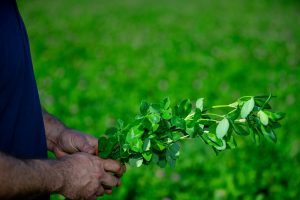A combination of crop performance and sustainability credentials is why sowing red clover is vital for reseeding plans in 2024.
Challenging weather, high input costs and a fast-moving sustainability agenda all affected livestock farming this year. With these pressures only set to increase and the weather only becoming more challenging, sowing red clover seed in next spring’s reseed to produce more high-quality homegrown forage can help mitigate them.
“Red clover is a high-quality, forage-driving solution that can also mitigate the effects of drought and driving your farm’s sustainability agenda,” says Germinal Agricultural Director Ben Wixey.
Combating dry conditions with red clover
In 2022, Southern England saw the driest July on record and even August with some heavy thunderstorms saw the UK only receiving 54% of its average rainfall for the month. Across the UK it’s been the driest year since 1976 so far and as grass yields fell clover’s performance stood out.
“This is when red clover’s deep taproot really came into play,” says Ben. “We saw red clover performing well across the country, particularly when sown in a multi-species sward. In a year seeing low forage stocks as grass growth suffered hugely, many red clover swards were producing 10-15 tonnes of dry matter per hectare.”

A nitrogen-fixing clover to reduce fertiliser need
AHDB figures for summer 2022 compared to the previous year showed UK-produced nitrogen fertiliser prices had increased by 152%, while imported fertiliser rose by 171%. As a result, many livestock farmers had hard decisions to make about how much, if any, to apply during the season.
Because red clover fixes nitrogen, it takes away this dilemma. By providing nitrogen for surrounding crops and subsequent plantings when ploughed back in, red clover reduces or even eliminates the requirement for N fertiliser applications.
“Increasing the red clover content in the sward helps reduce the amount of fertiliser needed without compromising plant or ruminant performance,” says Ben. “Reducing inputs also reduces the farm’s environmental footprint.”

Your sustainability hero
And red clover provides so much more than nitrogen. It drives milk production, liveweight gain and ewe yield. Compared to average grass silage, red clover silage has a higher dry matter (DM) percentage, metabolisable energy (ME) content and crude protein (CP) level – the latter being raised on average by 3%.
Red clover silage also contains the enzyme polyphenol oxidase (PPO) which further enhances this protein advantage. By combining with protein, PPO slows its breakdown in the rumen, making more of the protein in forage available to livestock and increasing its absorption.
Growing high-quality forage with good, well-used protein levels reduces the need for bought-in feed and lessens your environmental impact as well as your feed budget.
 Ben concludes: “As we see the industry moving towards incentives for achieving sustainability targets, the ability to grow high-quality forage and mitigate the need to buy in protein will only enhance your protein efficiency.
Ben concludes: “As we see the industry moving towards incentives for achieving sustainability targets, the ability to grow high-quality forage and mitigate the need to buy in protein will only enhance your protein efficiency.
“As a homegrown protein, red clover can help meet your farm’s sustainability goals. It improves soil fertility, enhances soil structure, improves feed quality and is drought tolerant. Incorporating red clover into your 2023 reseed makes huge sense.”
Ask a forage expert about red clover
